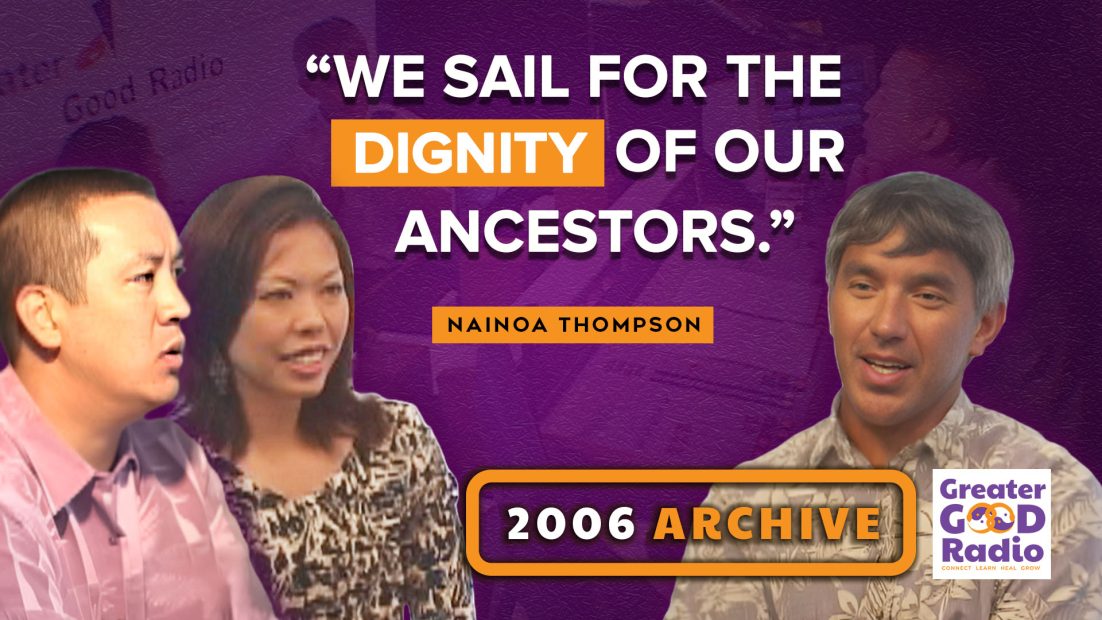How Did One Voyage Transform a Culture? Nainoa Thompson’s Incredible Journey
Join Nainoa Thompson, pwo (master) navigator and CEO of the Polynesian Voyaging Society, as he shares his profound journey of cultural revival and exploration in this archive episode of Greater Good Radio with hosts Evan and Kari Leong. Discover how the historic voyage of Hōkūleʻa not only reignited the Hawaiian spirit but also brought global awareness to the art of Polynesian wayfinding. Through personal stories of overcoming fear, embracing leadership, and navigating with purpose, Nainoa reflects on how one voyage transformed a culture and inspired generations. Don’t miss this incredible story of courage, tradition, and legacy.
The Cultural Renaissance of Hawai‘i
In the early 1970s, Hawaiian culture was at a crossroads. The language, traditions, and stories of Native Hawaiians were fading due to colonization and Western influence. At this pivotal time, the Polynesian Voyaging Society (PVS) was founded to challenge the longstanding belief that ancient Polynesians accidentally drifted across the Pacific. The Society, through the construction of a traditional double-hulled canoe called Hōkūleʻa, sought to prove that Polynesians had intentionally navigated the vast Pacific Ocean using advanced knowledge of the stars, winds, and ocean currents.
In 1976, the maiden voyage of Hōkūleʻa sailed from Hawai‘i to Tahiti, reigniting a sense of pride among Native Hawaiians. Yet, it was Nainoa Thompson, who two years later would face his greatest fears on the open ocean, who would come to symbolize the movement that reshaped not only Hawaiian culture but also the world’s view of traditional wayfinding.
Nainoa’s Early Challenges and Leadership
Nainoa’s journey was not without struggle. In the podcast, he recalls a harrowing moment in 1978 when Hōkūleʻa capsized in the Moloka‘i Channel, leading to the tragic loss of Eddie Aikau, a legendary Hawaiian surfer and lifeguard. This event plunged the voyaging community into grief and shame, leading some to question the future of the Polynesian Voyaging Society. However, this loss also became a catalyst for deeper reflection and commitment.
It was Nainoa’s father, a decorated WWII veteran, who imparted a lesson that would guide him through the most challenging moments: the power of vision. Nainoa learned that to be a navigator was not just about steering a canoe—it was about leading with purpose, understanding who you serve, and navigating with heart.
Overcoming Fear Through Wayfinding
One of the most profound aspects of Nainoa’s story is his relationship with fear. In his first voyage as a student navigator in 1980, Nainoa faced his greatest challenge: the doldrums, a region near the equator where the sun, moon, and stars are often obscured by clouds. He feared becoming “blind” without his celestial guides. Through the teachings of Mau Piailug, the last of the master navigators from Micronesia, Nainoa learned that true navigation comes from the heart. As Mau told him, “If you ever lose sight of the island in your mind, you will be lost.”
This lesson resonated with Nainoa as he sailed through uncharted waters, often unable to see the stars he relied on. He learned that successful wayfinding requires not only technical knowledge but also a deep sense of purpose, a commitment to the community, and an unwavering belief in the vision of what lies ahead. It was a turning point for him as a leader and navigator.
The Mālama Honua Worldwide Voyage
Fast forward to 2014, and Nainoa once again found himself at the helm of Hōkūleʻa, this time leading the Mālama Honua Worldwide Voyage. This global journey, which spanned over three years and covered more than 40,000 nautical miles, was a testament to the endurance of Polynesian wayfinding. The voyage aimed to spread the message of mālama honua, meaning “to care for the Earth,” and to inspire people worldwide to take action to protect our planet.
For Nainoa, this voyage was a continuation of the lessons learned over decades of voyaging: navigating not only the seas but also the complexities of our relationship with the environment. It was a global call to action, urging people to rethink how they live and how they interact with the Earth.
A Legacy of Learning and Teaching
Throughout his journey, Nainoa Thompson has remained committed to the next generation. As he shares in the podcast, “Your final role in voyaging is to teach.” For Nainoa, the success of Polynesian voyaging is not measured in miles but in the number of young navigators who will carry this knowledge forward. The Polynesian Voyaging Society has trained many new navigators, ensuring that the ancient practice of wayfinding will continue to inspire future generations.
Nainoa’s leadership, his ability to confront fear, and his dedication to cultural preservation have positioned him as a key figure in the Hawaiian Renaissance. The lessons he has imparted to his crew, and to the world, go far beyond sailing. They are about connecting with one’s identity, serving one’s community, and embracing the responsibility to protect the Earth for future generations.
Conclusion: The Power of Vision
Nainoa Thompson’s incredible journey is a testament to the transformative power of vision and leadership. His dedication to reviving traditional Polynesian navigation has reshaped Hawaiian culture and influenced environmental movements around the globe. The lessons from his voyages continue to inspire, reminding us that when we navigate with purpose and heart, we can overcome even the most daunting challenges.
As Nainoa reflected on his experiences, one thing became clear: this voyage was never just about finding Tahiti—it was about finding a path forward for his people, his culture, and the world.
CLICK HERE to SUBSCRIBE to our YouTube channel
Podcast: Play in new window | Download
Subscribe: Apple Podcasts | Spotify | RSS

